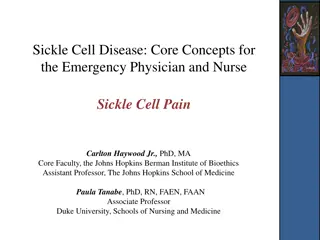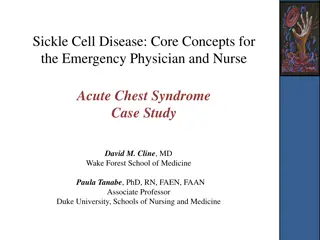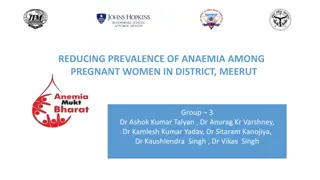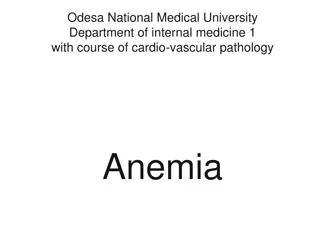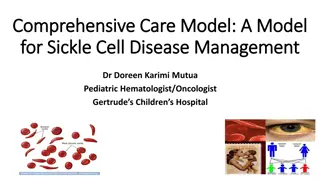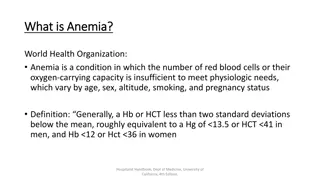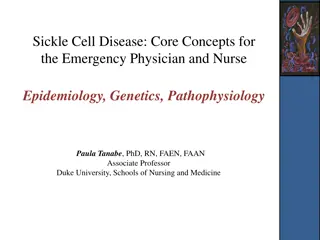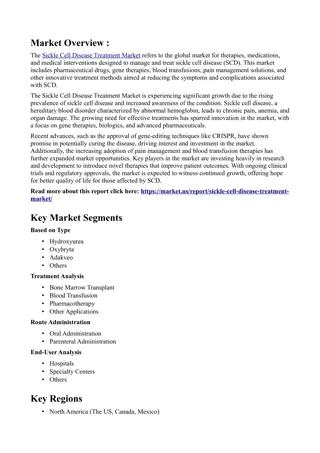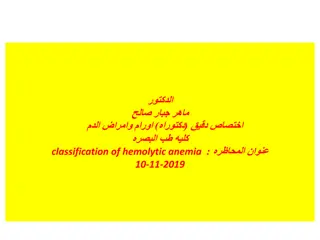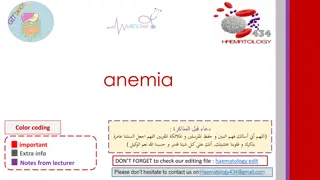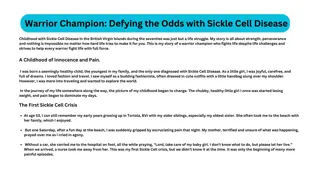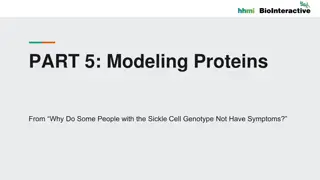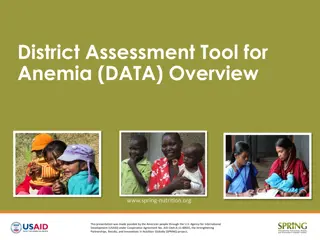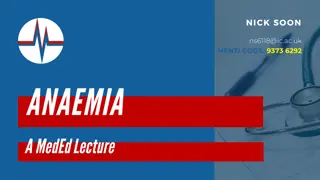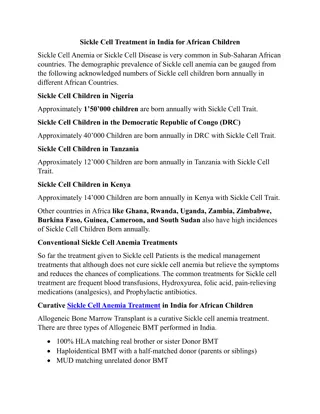Can You Tell It's Sickle Cell? Comms Toolkit
A campaign by NHS England and NHS Improvement to raise awareness of the signs and symptoms of Sickle Cell crisis among urgent emergency care staff and individuals living with the condition. The campaign also promotes uptake of an e-learning module on Sickle Cell and healthcare inequalities.
1 views • 17 slides
Vi-CELL.BLU - Advanced Cell Counting Instrument
Vi-CELL.BLU is a cutting-edge cell counting instrument that offers faster analysis, increased resolution, and improved optical sensor technology for enhanced cell concentration and viability assessments. The device features a user-friendly interface, Trypan blue method for live cell detection, and a
1 views • 19 slides
Palliative Care in Sickle Cell Disease: Enhancing Quality of Life
Explore the importance of palliative care in sickle cell disease, focusing on biopsychosocial factors and quality of life impacts. Review literature related to palliative care, advance care planning, and end-of-life care in SCD. Learn about potential roles for palliative care involvement to enhance
4 views • 41 slides
Medicaid and CHIP Coverage of New Treatments for Sickle Cell Disease
This communication highlights the Medicaid and Children's Health Insurance Program (CHIP) coverage of new treatments for Sickle Cell Disease (SCD), focusing on the approval of milestone gene therapies, Casgevy and Lyfgenia. It discusses the commitment of CMS to improving healthcare access, quality,
2 views • 13 slides
Understanding Sickle Cell Disease Pain Management
Sickle cell disease (SCD) patients often experience vaso-occlusive crises (VOC) causing acute pain, a hallmark symptom of the disease. Pain management is crucial in healthcare interactions for these patients, with chronic pain also being a significant concern due to organ/tissue damage. Research sho
1 views • 18 slides
Managing Acute Chest Syndrome in Sickle Cell Disease
A case study of a 31-year-old male with sickle cell disease presenting in the emergency department with a pain crisis. The patient has a history of avascular necrosis, priapism, NSTEMI, cholecystectomy, and previous acute chest syndrome. Explore the patient's symptoms, past medical history, and reco
7 views • 19 slides
Understanding Hemoglobin: Functions, Medical Applications, and Conditions
Hemoglobin, a crucial protein in red blood cells, plays a vital role in carrying oxygen throughout the body. This article delves into its functions, detection methods, medical applications, and common conditions associated with hemoglobin, such as anemia and polycythemia. Learn about the various typ
4 views • 16 slides
Advancements in Regenerative Medicine for Sickle Cell Anemia
Regenerative medicine holds promise for treating sickle cell anemia through techniques like stem cell transplantation. This approach targets genetic blood diseases, offering potential cures beyond traditional uses like eradicating cancer. Despite obstacles like toxicity and donor availability, innov
8 views • 26 slides
Addressing Anemia Among Pregnant Women in Meerut District
Anemia is a prevalent condition among pregnant women in Meerut, India. The Anemia Mukt Bharat program aims to reduce anemia rates by providing iron and folic acid supplements through ANC services. Data analysis shows progress in ANC registration and iron tablet consumption, highlighting the importan
0 views • 11 slides
Understanding Sickle Cell Trait in Intercollegiate Athletics
Sickle cell trait is a hereditary condition affecting red blood cells' shape and oxygen-carrying capacity. Individuals with this trait can experience complications during intense exercise, leading to health risks in athletics. This article explores the impact of sickle cell trait on athletes, the re
0 views • 15 slides
Understanding Clinical Features of Anemia
Clinical features of anemia include cardiovascular adaptations, variations in symptom presentation based on speed and severity of onset, implications of age, and changes in the hemoglobin-O2 dissociation curve. Symptoms may range from breathlessness and weakness to cardiac issues, while signs like p
0 views • 28 slides
Understanding Red Blood Cell Abnormalities in Anemia: A Detailed Overview
This in-depth article delves into the various types of red blood cell abnormalities seen in anemia, such as anisocytosis, poikilocytosis, spherocytes, ovalocytes, acanthocytes, codocytes, drepanocytes, and stomatocytes. It explains the characteristics of each abnormality, their significance in diffe
0 views • 45 slides
Comprehensive Care Model for Sickle Cell Disease Management
Comprehensive care is crucial for managing sickle cell disease, the most common haemoglobinopathy worldwide. Despite advancements in high-income countries, challenges persist in low and medium-income nations, leading to preventable deaths, especially in Africa. A comprehensive care approach has sign
0 views • 15 slides
Understanding Anemia: Causes, Mechanisms, and Classifications
Anemia is a condition characterized by a deficiency in red blood cells or their oxygen-carrying capacity, impacting physiological needs. Causes include blood loss, decreased production, and destruction of red blood cells. There are various classifications such as acute and chronic blood loss anemia,
0 views • 19 slides
Anemia in Swine: Causes, Clinical Signs, and Treatment
Anemia in swine can be caused by factors such as gastric ulcers, internal bleeding, and poor nutrition. Clinical signs include pale skin, rapid breathing, and jaundice. Piglet anemia, a highly fatal disease, is marked by decreased hemoglobin levels and liver degeneration. Diagnosis involves examinin
0 views • 11 slides
Understanding Sickle Cell Disease: Core Concepts for Healthcare Professionals
Sickle Cell Disease (SCD) is a genetic disorder primarily affecting individuals of African descent but also found in other ethnic groups. The most severe form is sickle cell anemia (SS), presenting with life-threatening complications. This article explores the epidemiology, genotypes, and changes in
0 views • 18 slides
Community Specialist Nursing Care for Sickle Cell & Thalassaemia Patients
Promoting understanding of health & social challenges faced by individuals living with sickle cell disease and thalassaemia major. Discusses referral & care pathways, role of specialist nurses, and resources for primary care support. Emphasizes the importance of managing psychological impact, stigma
0 views • 12 slides
Sickle Cell Disease Treatment Market
The Global Sickle Cell Disease Treatment Market size is expected to be worth around USD 6.9 Billion by 2032 from USD 1.9 Billion in 2022, growing at a CAGR of 14.10% during the forecast period from 2023 to 2032.\n\n
0 views • 3 slides
Understanding Hemolytic Anemia: Classification and Management
Hemolytic anemia encompasses various subtypes like autoimmune hemolytic anemia, with warm and cold antibodies, each requiring unique management strategies. Diagnosis involves specific investigations like the Coombs test. Treatment typically involves corticosteroids as first-line therapy, while secon
1 views • 23 slides
Understanding Anemia: Key Concepts and Clinical Features
Anemia is a common condition characterized by a reduction in hemoglobin levels, leading to decreased oxygen-carrying capacity in the blood. This article delves into important aspects such as hematopoiesis, erythropoiesis, hemoglobin synthesis, and clinical manifestations of anemia. Learn about the s
0 views • 18 slides
Overview of Cell Division in Prokaryotes and Eukaryotic Cells
Cell division plays a crucial role in the growth and reproduction of all organisms. In prokaryotic cells, binary fission is the primary mode of division, while eukaryotic cells undergo a more complex process involving cell growth, DNA replication, chromosome distribution, and cytokinesis. The cell c
0 views • 10 slides
Understanding Anemia: Causes, Symptoms, and Classification
Anemia is characterized by a reduction in hemoglobin (Hg) concentration, hematocrit (Hct) concentration, or red blood cell (RBC) count. Common symptoms include fatigue, weakness, dizziness, and palpitations. Physical signs may include pallor and tachycardia. Pica, characterized by unusual cravings,
0 views • 23 slides
Newborn Screening Program Challenges in Africa
Newborn screening programs, particularly for diseases like sickle cell anemia, face challenges in adoption in African countries such as Nigeria despite their proven benefits. The Yoruba people, who dominate the southwestern part of Nigeria, have a significant population, and efforts are being made t
0 views • 11 slides
Understanding the Impact of Cold Weather on Sickle Cell Disease
Patients with sickle cell disease (SCD) often experience painful episodes known as sickle cell crises due to abnormally shaped red blood cells. The severity of SCD can be influenced by genetic and environmental factors, with cold weather being linked to increased pain episodes. Research has shown co
0 views • 27 slides
Understanding Natural Selection in Higher Biology
Natural selection in action is demonstrated through mutations that impact an organism's adaptation to changing environments. Sickle cell anemia, a genetically transmitted blood disorder, exemplifies the consequences of specific mutations. The condition manifests in various symptoms, affecting indivi
0 views • 18 slides
Understanding Sickle Cell Anemia: Causes, Symptoms, and Pathophysiology
Sickle cell anemia is an inherited disorder affecting red blood cells' shape, leading to decreased oxygen delivery and various symptoms like fatigue, pain episodes, and more. The condition arises from a genetic mutation affecting hemoglobin production. Individuals with sickle cell trait may not disp
0 views • 7 slides
Role of Cell Cycle in Nanoparticle Uptake and Dilution in Cell Population
The cell cycle plays a crucial role in the cellular uptake and dilution of nanoparticles within a cell population. This process involves different phases such as G1, S, G2, and M, each with specific functions related to cell growth, DNA synthesis, protein synthesis, and cell division. Understanding
0 views • 20 slides
Warrior Champion: Defying the Odds with Sickle Cell Disease
Childhood with Sickle Cell Disease in the British Virgin Islands during the seventies was just but a life struggle. My story is all about strength, perseverance and nothing is impossible no matter how hard life tries to make it for you. This is my st
1 views • 6 slides
Individualized Medicine and Biophysical System Dynamics in End-Stage Renal Disease
This presentation delves into the management of anemia in dialysis patients using system dynamics modeling, particularly at Mayo Clinic. Chronic kidney disease, hemodialysis, anemia, and the significance of erythropoietic stimulating agents are discussed. Anemia poses a key quality of life issue for
0 views • 26 slides
Implementing Newborn Screening for Sickle Cell Disease
Establishing a program for newborn screening of sickle cell disease is crucial for early identification and intervention, reducing associated mortality and morbidity. Key principles and practices, including the importance of analytical validity and safe interventions, underscore the need for informe
0 views • 41 slides
Exploring Protein Modeling in Sickle Cell Genotype
Dive into the world of protein modeling to understand why some individuals with the sickle cell genotype remain asymptomatic. Explore amino acid sequences, build typical and sickle cell protein segments, and visually represent the changes in protein structure. Hands-on instructions guide you through
0 views • 6 slides
District Assessment Tool for Anemia (DATA) Overview
This presentation highlights the development and purpose of the District Assessment Tool for Anemia (DATA), emphasizing its role in addressing anemia as a multi-sectoral issue at the district level. The tool aims to assist stakeholders in identifying gaps, enablers, and barriers to tackling anemia r
0 views • 20 slides
Understanding Anemia: Causes, Symptoms, and Diagnosis
Anemia is a condition characterized by low red blood cell count, leading to symptoms like fatigue, pale skin, and shortness of breath. Causes range from nutritional deficiencies to chronic diseases. Diagnosis involves blood tests and examination of red blood cells. This content delves into various t
0 views • 52 slides
Understanding Anemia: Causes, Types, and Impact on Indian Population
Anemia is a serious health condition characterized by low hemoglobin levels, leading to reduced oxygen supply to the body. This article delves into the definition of anemia, its types - including genetic and nutritional anemia, and highlights the significant prevalence of anemia in India, especially
0 views • 16 slides
Impact of Nurse Practitioner-Led Pain Management on Sickle Cell Disease Outcomes in African American Adults
Exploring the effects of individualized pain management plans led by nurse practitioners on length of stay, 30-day readmission rates, and quality of care for African American adults with sickle cell disease. The study aims to assess the potential benefits of this approach in improving healthcare out
0 views • 30 slides
Understanding Cell Structure and Function
Explore the intricate world of cell biology through this comprehensive guide covering the definition of a cell, the characteristics of animal cells, the role of the nucleus, ribosomes, cell structure, organelles, cell membrane, and cell wall. Discover the fascinating details of eukaryotic cells and
0 views • 61 slides
Understanding the Functions of Cell Organelles
Explore the vital functions of different cell organelles such as the cell membrane, nucleus, endoplasmic reticulum, lysosomes, Golgi apparatus, mitochondria, cytoplasm, ribosomes, vacuole, cell wall, chloroplasts, and chlorophyll in a cell. Learn how each organelle plays a unique role in maintaining
0 views • 38 slides
Anemia in Pregnancy: Types, Etiology, and Management
Dr. Methal A. Alrubaie, an assistant professor, presents a detailed overview of anemia in pregnancy. The content covers the classification of anemia types, their etiology, clinical presentation, effects on both mother and fetus, investigation methods, and treatment approaches. Various types of anemi
0 views • 19 slides
Understanding Animal Tissue Culture and Cell Line Production
Animal tissue culture involves growing tissues separate from the animal in a laboratory setting. To achieve exponential cell growth, cells are converted into immortal cell lines. The production of a cell line involves steps like breaking cell adhesion, incubation, and transferring cells to fresh med
0 views • 22 slides
Sickle cell Anemia treatment in India for African Children
Sickle Cell Treatment in India for African Children\nSickle Cell Anemia or Sickle Cell Disease is very common in Sub-Saharan African countries. The demographic prevalence of Sickle cell anemia can be gauged from the following acknowledged numbers of
1 views • 3 slides




